| Article ID | Journal | Published Year | Pages | File Type |
|---|---|---|---|---|
| 6740639 | Engineering Structures | 2015 | 17 Pages |
Abstract
Scour has been reported as the cause of approximately half of bridge failures in the United States. It alters static and dynamic characteristics of bridges and may lead to excessive deflections and increased maximum actions induced in structural members. To estimate the response of bridges under scour conditions, comprehensive models of representative bridges that overpass waterways are developed in this study. The bridge models account for the nonlinear soil-pile-structure interactions, the nonlinear response of the abutments and columns, as well as the predominantly linear contribution of the superstructure. Different types of scour, including local scour, general scour, and aggradation/degradation are investigated and their effects on the bridge structural system are quantified. The lateral response of the structure is studied as it varies dependent on the composition of the supporting soil profile and the magnitude of the scour depth. In addition, a set of scour scenarios is introduced to represent varying scour intensities that a bridge may experience during its service life. The effects of scour on the lateral performance of a case study bridge/soil profile have been evaluated using the developed analysis procedure. The outcome of this study is an efficient approach that can be used for the design and assessment of bridges under extreme scour conditions.
Related Topics
Physical Sciences and Engineering
Earth and Planetary Sciences
Geotechnical Engineering and Engineering Geology
Authors
John V. Klinga, Alice Alipour,
